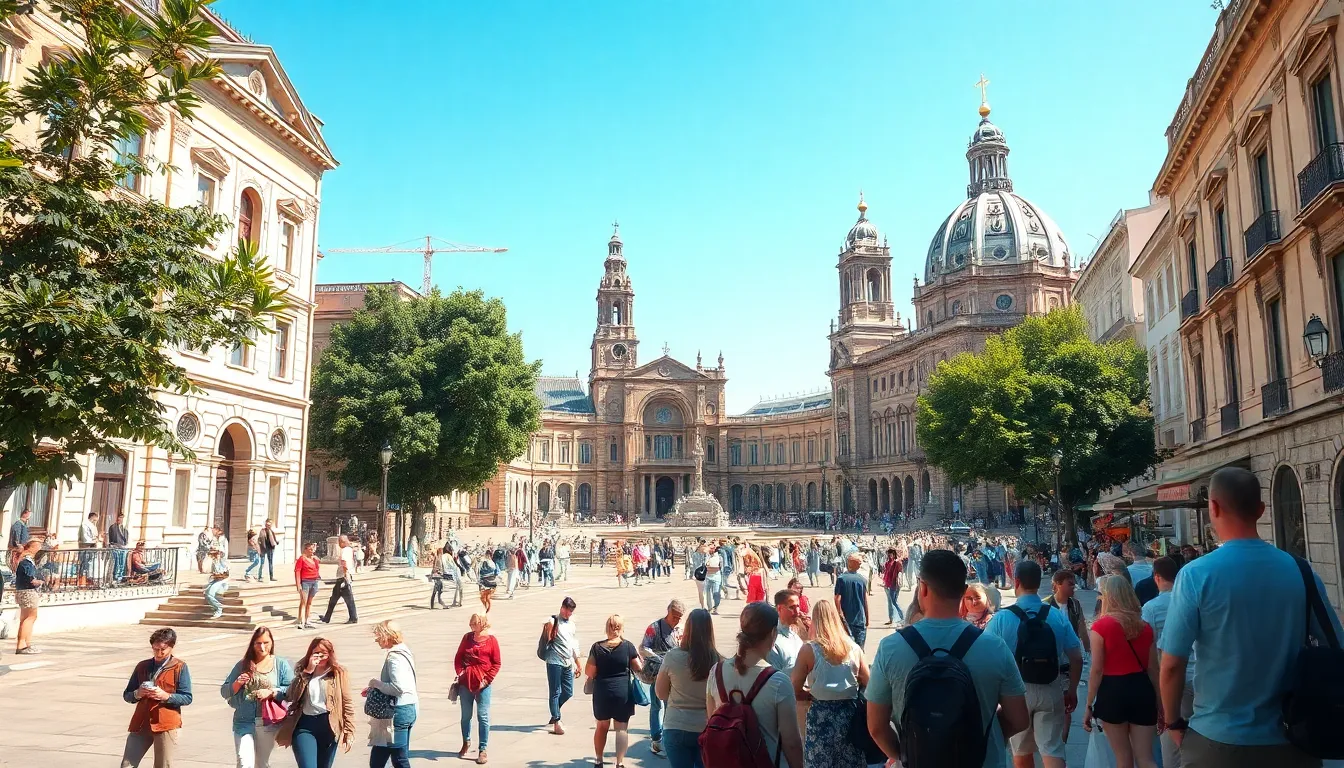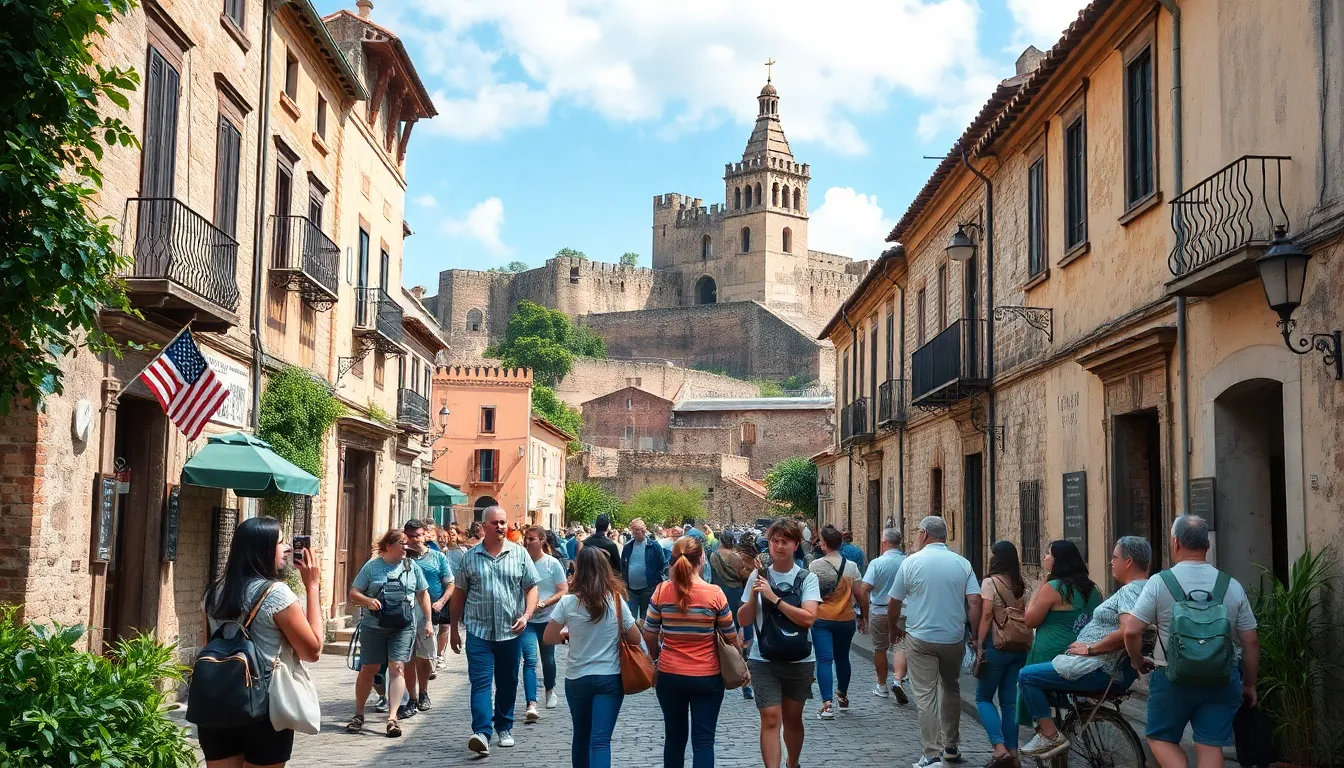Every city has its secrets, and historical sites are the treasure maps leading to them. Imagine walking the same cobblestone streets where kings and queens once strolled, or standing in the shadow of a crumbling fortress that’s seen more drama than a reality TV show. These locations aren’t just dusty relics; they’re vibrant storytellers, whispering tales of triumph, tragedy, and the occasional royal scandal.
Table of Contents
ToggleOverview of Historical City Sites
Historical city sites serve as gateways to the past, revealing stories intertwined with culture, architecture, and the people who shaped them. Each site presents a unique glimpse into history, allowing visitors to engage with the narratives of bygone eras. Cobblestone streets often teem with tales of royalty walking through old marketplaces, providing a vivid connection to the lives once lived there.
Significant structures like ancient fortresses stand proudly, showcasing architectural mastery while bearing witness to pivotal moments in history. Cities around the world boast ruins, monuments, and preserved buildings that echo the triumphs and trials of their inhabitants. These landmarks contribute to rich tourism, drawing millions each year eager to explore their depths.
Explorations of historical sites often foster appreciation for diverse heritages. They prompt curiosity about how earlier societies functioned and thrived in their environments. Much of the world’s historical significance finds its home in these urban settings, enabling a deeper understanding of local traditions and global influences.
Educational institutions and museums frequently flourish near these sites, facilitating further learning and preservation efforts. Additionally, restoration projects ensure that future generations can appreciate and learn from these vital historical resources. Event planners often leverage such locations for cultural festivals or heritage days, celebrating the history that shapes current identities.
Heritage trails and guided tours enhance the experience, leading visitors to explore multiple interconnected sites within a city. Contextual information provided at each location enriches understanding and fosters a more immersive experience. As a result, these historical city sites not only preserve the past but also foster a community-centric appreciation of history’s impact on contemporary life.
Importance of Preserving Historical City Sites

Preserving historical city sites is crucial for honoring our shared heritage. These sites embody cultural narratives, historical events, and architectural achievements that resonate through generations.
Cultural Significance
Cultural identity frequently finds expression through historical city sites. They serve as tangible links to traditions, beliefs, and customs passed down over time. Visiting these sites allows individuals to connect with their ancestry and promotes dialogue between diverse communities. Historic architecture reflects artistic movements and societal values, enriching the collective identity. In many instances, festivals and events occur at these sites, further strengthening cultural bonds and fostering a sense of belonging among residents and visitors alike.
Educational Value
Educational opportunities abound around historical city sites. Visitors gain insights into past societies, political structures, and daily life, enhancing historical understanding. Museums and guided tours often accompany these sites, providing in-depth information about their significance. Classroom learning benefits from field trips to these locations, allowing students to engage with history in an immersive way. Scholars utilize these sites for research, contributing to broader discussions about heritage and preservation. Engaging with these sites stimulates curiosity and respect for history, cultivating informed citizens who value their past.
Notable Historical City Sites Around the World
Historical city sites span various themes, each contributing to the rich tapestry of human experience. Exploring these sites reveals profound insights into cultures and events.
Ancient Ruins
Ancient ruins captivate visitors with their enduring presence. Structures like the Colosseum in Rome and Machu Picchu in Peru showcase architectural brilliance from long-lost civilizations. The Great Wall of China reflects the ingenuity of early dynasties, measuring over 13,000 miles. These sites evoke feelings of wonder while providing glimpses into daily life centuries ago. Archaeological discoveries continue to reshape understanding of ancient societies, making these ruins essential for historical study and tourism.
Colonial Architecture
Colonial architecture highlights the diverse influences of empires around the world. Cities like New Orleans and Quebec feature buildings that express unique cultural fusions. The intricate designs of the Colonial Williamsburg area in Virginia transport visitors back to America’s early days. European influences meld with local traditions, creating distinct styles in places like Mexico City and Lima. These architectural marvels illustrate the complexities of colonization while serving as reminders of cultural exchanges that shaped national identities.
Modern Historical Sites
Modern historical sites often commemorate pivotal events that shaped contemporary societies. Landmarks like the Berlin Wall in Germany symbolize the struggle for unity and freedom. Memorials such as the 9/11 Memorial in New York City serve as powerful reminders of resilience in the face of tragedy. UNESCO World Heritage Sites like the Sydney Opera House showcase innovative design while promoting artistic expression. These destinations invite reflection on human experiences and foster discussions about progress, tolerance, and historical legacy.
Challenges in Preserving Historical City Sites
Preserving historical city sites faces several significant challenges that impact their survival and integrity.
Urban Development
Urban development threatens historical city sites through modern infrastructure projects. Growing populations necessitate housing and commercial spaces, often leading to site demolitions. Preserving the architectural integrity of historic landmarks becomes secondary to economic growth. Cities like Rome and Paris struggle to balance development with conservation. Notably, zoning laws can conflict with preservation efforts, complicating restoration projects. Local governments may prioritize immediate economic benefits, undermining the longer-term cultural value of unique sites. Collaboration among stakeholders is essential to navigate these opposing interests. Innovative approaches such as adaptive reuse programs offer viable solutions. Ultimately, integrating historical preservation into urban planning creates a sustainable environment.
Climate Change
Climate change poses an increasing threat to historical city sites worldwide. Rising sea levels endanger coastal landmarks like Venice’s St. Mark’s Basilica. Additionally, more frequent extreme weather events, such as hurricanes and flooding, can deteriorate structural integrity. Preservation efforts become more urgent as weather patterns continue to shift. Historic masonry and woodwork suffer as moisture levels fluctuate, accelerating decay. Financial resources are often limited for restoration projects, compounding the challenges. Implementing resilient design strategies can mitigate some climate impacts, but proactive measures require widespread commitment. Increased awareness and education about these challenges among communities can help foster solutions. Engaging with experts on historical preservation and environmental science is crucial for effective strategies.
Future of Historical City Sites
Preservation efforts for historical city sites face both challenges and opportunities. Urban development pressures often clash with conservation goals. Innovative strategies like adaptive reuse can breathe new life into dilapidated structures, transforming them into functional spaces while respecting their historical significance. Collaboration between governments, private sectors, and communities plays a crucial role in successful preservation initiatives.
Technology continues to enhance the preservation landscape. Digital mapping and 3D modeling allow for detailed documentation of historical sites, aiding restoration efforts. Augmented reality applications provide immersive experiences, inviting people to visualize historical narratives in real-time. Such advancements attract a younger audience eager to engage with history.
Sustainability also emerges as a critical consideration for the future of these sites. Incorporating eco-friendly practices into restoration projects reduces environmental impact while maintaining cultural integrity. Green infrastructure, such as sustainable drainage systems, balances modernization with historical preservation.
Global tourism trends indicate an increased interest in heritage travel. Tourists seek authentic experiences, leading to more traffic at historical sites. This trend offers an economic boost, allowing cities to fund restoration efforts and promote education about their heritage. Educating the public about the importance of these sites ensures ongoing support for preservation initiatives.
Investments in public engagement initiatives can strengthen community ties to historical sites. Local festivals, art installations, and educational programs foster appreciation for cultural heritage. With such initiatives, historical sites evolve from mere landmarks to vibrant community hubs.
Addressing climate change impacts must remain a priority for the future. Rising sea levels and extreme weather conditions threaten many coastal historic sites. Implementing resilient design strategies safeguards these structures, ensuring they withstand environmental challenges.
Historical city sites are more than just remnants of the past; they’re living narratives that connect people to their heritage. By exploring these landmarks, individuals gain insights into the cultural and architectural achievements that shaped societies.
The preservation of these sites is crucial for fostering a sense of identity and belonging within communities. As challenges like urban development and climate change threaten their existence, innovative solutions and public engagement become vital.
With a growing interest in heritage travel, cities have the opportunity to revitalize these treasures while promoting economic growth. Embracing technology and sustainable practices will ensure that future generations can continue to explore and learn from these invaluable historical sites.



